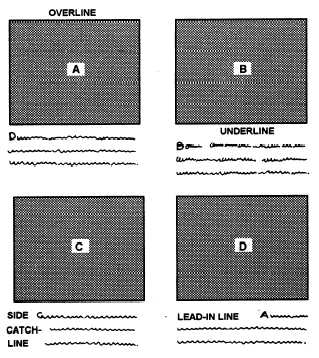CUTLINE LAYOUT
Figure 9-17.—The four basic caption forms: (A) overline (B) under-
line, (C) side catchline and(D) lead-in line.
Its function is essentially the same as those used over a
news story as follows:
c To summarize
. To attract attention
l To dress up the page
There are several kinds of captions in this context.
An overline runs above the photograph. An underline
runs between the photograph and the cutline. The side
catchline is used with photographs of three columns or
more and runs on the left side of the cutline. If a headline
is not used, the first few words of the cutline maybe set
in boldface or all capital letters to serve as a lead-in line.
These four types of captions are shown in figure 9-17.
All such display lines should be in large type, preferably
the kind used in a small headline.
Mortised Photographs
Photographs that contain dead areas of sky or
unimportant background can be mortised (a rectangular
window, or space, is cut out and the cutline is placed in
the space). This saves page space and may actually
improve the photograph.
When laying out a page, you should treat each
photograph and its cutline as one unit. The relationship
of photograph to cutline must be obvious. Readers will
seldom spend much time hunting for misplaced cutlines.
In addition, cutlines may be run beside or above
photographs. This adds variety, and in some cases,
enhances page layout.
It is a common practice for most newspapers to run
the story and accompanying photographs side by side.
Because of space limitations, however, this is
impractical at times. If a story and an accompanying
photograph must be separated in a newspaper for any
reason, the two are still “keyed” together. For example,
if the photograph appears on page one and the story on
page four, the cutline will carry a line that says “Story
on page 4.” This keys the two together for the reader’s
convenience.
There are times when a newspaper may not have
space to publish both story and photograph. When this
happens, one or the other will be discarded. If it is the
story that gets the toss, the cutline must be rewritten to
include more details.
When a photograph and cutline are released with a
story or when you are writing a story and cutline for your
command’s newspaper, the best practice is to write the
story first. After the story is written, write the cutline for
the photograph. There are two important reasons for
this — (1) it enables you to avoid any duplication of
phrases or ideas that appear in the story and (2) it enables
you to write tighter, more compact cutlines. After
writing the story, you have the salient features clear in
your mind, and the act of paring the cutline down to its
essentials becomes much easier.
DATELINES
When preparing cutlines for photographs to be
released externally, you need not concern yourself with
display lines. You merely write your cutline in complete
and simple sentence form. An additional component
must accompany a cutline for outside release — the
dateline.
The dateline answers the question “where?” and is
used as a lead-in to the cutline. For example, a datelined
cutline might read: “ABOARD THE USS UNITED
STATES AT SEA — Carrier pilots leave . ..”
Additional information on datelines maybe found
in The Associated Press Stylebook and Libel Manual.
9-17



